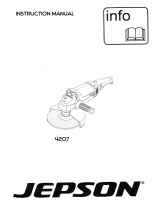CONTENTS
Page
IMPORTANT SAFETY INFORMATION ................ 3
MEANINGS OF SIGNAL WORDS ........................ 3
SAFETY ...................................................................... 4
GENERAL SAFETY RULES ................................... 4
SPECIFIC SAFETY RULES AND
SYMBOLS ....................................................... 6
DOUBLE INSULATION FOR SAFER
OPERATION ................................................... 8
FUNCTIONAL DESCRIPTION .................................. 10
NAME OF PARTS ................................................ 10
SPECIFICATIONS ................................................ 10
Page
ASSEMBLY AND OPERATION ............................... 11
APPLICATIONS ................................................... 11
PRIOR TO OPERATION ....................................... 11
GRINDER OPERATION ....................................... 13
DEPRESSED CENTER WHEEL
ASSEMBLY AND DISASSEMBLY ............... 14
MAINTENANCE AND INSPECTION ....................... 15
ACCESSORIES ......................................................... 17
STANDARD ACCESSORIES ............................... 17
PARTS LIST .............................................................. 48
TABLE DES MATIERES
ÍNDICE
English
Français
Page
INFORMATIONS IMPORTANTES DE
SÉCURITÉ ..................................................... 18
SIGNIFICATION DES MOTS
D’AVERTISSEMENT .................................... 18
SECURITE ................................................................ 19
REGLES GENERALE DE SECURITE ................... 19
REGLES DE SECURITE SPECIFIQUES
ET SYMBOLES ............................................. 21
DOUBLE ISOLATION POUR UN
FONCTIONNEMENT PLUS SUR ................. 23
DESCRIPTION FONCTIONNELLE ........................... 25
NOM DES PARTIES ............................................ 25
SPECIFICATIONS ................................................ 25
Page
ASSEMBLAGE ET FONCTIONNEMENT ................ 26
UTILISATIONS .................................................... 26
AVANT L’UTILISATION ...................................... 26
UTILISATION DE LA MEULEUSE ...................... 28
ASSEMBLAGE ET DESASSEMBLAGE
DE LA MEULE A DEPRESSION
CENTRALE .................................................... 29
ENTRETIEN ET INSPECTION .................................. 30
ACCESSOIRES ......................................................... 32
ACCESSOIRES STANDARD ............................... 32
LISTE DES PIECES ................................................... 48
Español
Página
INFORMACIÓN IMPORTANTE SOBRE
SEGURIDAD ................................................. 33
SIGNIFICADO DE LAS PALABRAS DE
SEÑALIZACIÓN ............................................ 33
SEGURIDAD ............................................................. 34
NORMAS GENERALES DE SEGURIDAD ........... 34
NORMAS Y SÍMBOLOS ESPECÍFICOS
DE SEGURIDAD ........................................... 36
AISLAMIENTO DOBLE PARA OFRECER UNA
OPERACIÓN MÁS SEGURA ........................ 38
DESCRIPCIÓN FUNCIONAL .................................... 40
NOMENCLATURA ............................................... 40
ESPECIFICACIONES ............................................ 40
Página
MONTAJE Y OPERACIÓN ...................................... 41
APLICACIONES ................................................... 41
ANTES DE LA OPERACIÓN ................................ 41
OPERACIÓN DE LA AMOLADORA
ANGULAR .................................................... 43
MONTAJE Y DESMONTAJE DE LA
RUEDA DE DISCO ABOMBADO ................. 44
MANTENIMIENTO E INSPECCIÓN ........................ 45
ACCESORIOS ........................................................... 47
ACCESORIOS ESTÁNDAR ................................. 47
LISTA DE PIEZAS .................................................... 48






















